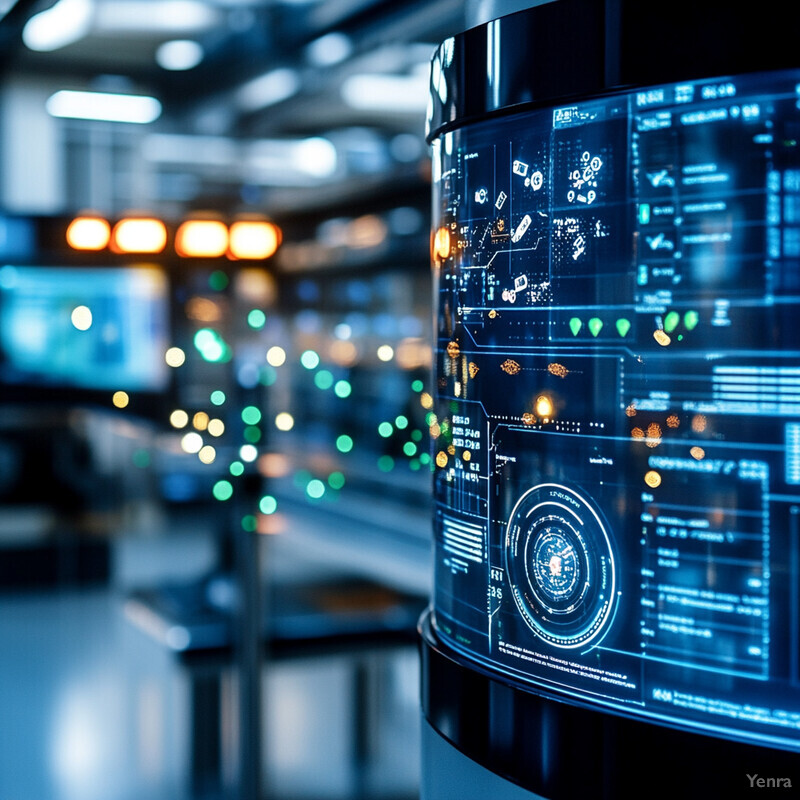1. Automated Prescription Verification
AI-driven verification systems cross-check prescription details against patient records to catch errors before medication is dispensed. By using natural language processing to read prescriptions and optical character recognition to interpret labels, these tools ensure the prescription matches the patient’s profile. This reduces human transcription mistakes and flags issues like incorrect dosages or missing information. Automating verification boosts accuracy and frees pharmacists to focus on patient care instead of manual double-checking. Overall, AI verification adds a safety net that improves compliance with regulations and consistency in dispensing.

In a 2025 randomized trial, pharmacists assisted by an AI verification tool caught incorrect medications at significantly higher rates. With AI help, 96.1% of wrong-drug errors were identified, compared to only 81.2% caught with manual review. The study’s AI provided confidence estimates (“uncertainty-aware” advice), which further improved decision accuracy and speed. These findings show that AI-powered prescription checks can dramatically reduce dispensing errors and accelerate the verification process. Another 2023 focus-group study with pharmacists emphasized that such AI systems must provide clear explanations and fit into workflow to be trusted. When designed with user feedback, AI verification tools can enhance safety without disrupting pharmacy operations.
2. Enhanced Accuracy in Drug Selection
AI and computer vision technologies enable robotic dispensers to accurately identify medications by appearance, reducing look-alike drug mix-ups. High-resolution cameras and machine learning models recognize pills by color, shape, and imprint, ensuring the robot selects the correct drug and strength every time. This visual verification provides an extra layer of safety beyond barcodes. By learning from thousands of pill images, the system becomes adept at distinguishing even subtle differences between similar-looking tablets. Over time, as more data is processed, the AI’s identification accuracy continuously improves. The result is a dramatic drop in wrong-drug errors and greater confidence that patients get the exact medication intended.

Recent studies demonstrate the high precision of AI pill identification. A 2023 development effort trained a deep learning model on U.S. and Korean pill images, achieving 85.65% top-1 accuracy in identifying unseen pills (and over 92% accuracy when the top-3 candidates were considered). Even with consumer-taken photos, the system correctly recognized about 78% of pills on the first guess. By combining image analysis with imprint text recognition, the AI outperformed earlier methods and improved with each additional sample. Such computer vision tools are already used in pharmacies to double-check that the robotic arm picked the right pill from storage. As an example, one hospital reports that its image-guided dispensing robots virtually eliminated wrong-drug and wrong-strength errors, driving those error rates to near zero. These data underscore how AI vision systems bring a new level of accuracy to drug selection in automated dispensing.
3. Real-Time Error Detection
AI-driven dispensing platforms can intercept errors at the moment of dispense, before the medication reaches the patient. These systems cross-check each transaction in real time against clinical rules and patient data. For example, if a robot selects an incorrect dosage form or a drug that interacts with a patient’s other meds, the AI will immediately flag the issue. By analyzing prescription details, known drug–drug interactions, and allergy information on the fly, the technology catches mistakes that humans might miss under time pressure. Real-time alerts allow pharmacists to correct problems (like a wrong formulation or a potential contraindication) before the medication leaves the automated unit. This proactive error detection significantly improves patient safety by preventing dispensing errors at their last possible checkpoint.

Cutting-edge implementations show near-perfect detection of medication errors in real time. In one 2024 study, researchers used an AI-enabled camera system to watch medication preparations and caught vial-swap errors with 99.6% sensitivity and 98.8% specificity in the moment. The system recognized if the wrong drug vial was being used and alerted staff before administration. AI is also being harnessed to uncover dangerous drug interactions that traditional checks might overlook. A Vanderbilt-led analysis in 2024 used AI to mine millions of medical records and identified nine severe drug–drug interactions (like methadone + ciprofloxacin causing respiratory depression) that had been missed by standard drug knowledge databases. Those previously unflagged interaction risks were confirmed by AI analysis of patient outcomes. These examples illustrate how real-time AI surveillance and big-data analytics can preempt medication errors – from technical dispensing slip-ups to clinical interaction hazards – enhancing safety before an error reaches the patient.
4. Predictive Inventory Management
AI is optimizing pharmacy inventory by forecasting medication demand more accurately than traditional methods. Machine learning models analyze prescription trends, seasonal illness patterns, and even local demographic data to predict which drugs will be needed and in what quantities. Using these predictions, automated systems keep stock levels optimal – avoiding both shortages and overstock. This means critical medications are on hand when patients need them, but excess inventory (which can lead to expirations and waste) is minimized. Predictive inventory management also streamlines ordering and restocking schedules, since the AI anticipates future needs and triggers orders just in time. The net effect is fewer stock-outs, less capital tied up in inventory, reduced waste from expired drugs, and a smoother supply of medicines to meet patient demand.

The impact of AI on pharmacy inventory management is strikingly illustrated by the UK’s National Health Service (NHS) adopting a predictive system across multiple hospitals. After implementing AI-driven inventory optimization in 15 hospital pharmacies, the NHS reported 55% fewer stock-outs of medications (i.e., drugs were rarely out of stock) and a 40% reduction in inventory spending due to lower waste and overstock. Inventory turnover (how fast stock is used and replaced) improved by 70%, reflecting far more efficient use of supplies. This translated to roughly €2.3 million in annual savings for the network. U.S. providers are seeing similar benefits. For instance, advanced analytics platforms like LogicStream Health apply machine learning to hospital pharmacy data to flag looming drug shortages and adjust orders preemptively. These AI-based solutions have given pharmacies powerful tools to manage shortages: one major health system was able to identify and mitigate drug supply issues before they occurred, helping ensure essential medications remained available during surges. Together, such results show that predictive analytics can make pharmacy supply chains more resilient and cost-effective, directly translating to better patient care through continuous medication availability.
5. Adaptive Workflow Optimization
AI technologies dynamically adjust pharmacy workflows in real time to maximize efficiency. Instead of a fixed dispensing sequence, the system can reprioritize tasks based on current conditions – for example, fast-tracking an urgent prescription or reordering steps if one medication is temporarily unavailable. This adaptability means the robot and software continually seek the most efficient path to get all prescriptions filled accurately and on time. During peak periods, AI might deploy multiple robotic arms in parallel or reorganize the queue to prevent bottlenecks. It can also adjust to external factors: if a particular drug station is backed up, the system routes tasks to a free station. By continuously monitoring throughput and task statuses, AI keeps the dispensing operation flowing smoothly. The outcome is shorter wait times for patients, better utilization of robotic capacity, and a more balanced workload for pharmacy staff.

Hospitals using AI-driven workflow optimization have documented major improvements in pharmacy operations. Memorial Sloan Kettering Cancer Center introduced an AI-powered scheduling and verification system for its chemotherapy pharmacy, which must handle very complex, time-sensitive drug regimens. After implementation, the center saw an 80% reduction in medication preparation errors for chemotherapy doses. The improved accuracy and coordination also made the workflow 45% more efficient, allowing pharmacists and technicians to process nearly half again as many orders in the same time. Critically, the AI system sped up verification steps by 50%, greatly reducing delays in delivering chemo to patients. Another example comes from outpatient pharmacy: a machine learning model deployed at a large pharmacy chain analyzed foot traffic and prescription data to predict the busiest hours each day. This enabled the pharmacy to smartly schedule staff and automate certain tasks, cutting average patient wait times by 50% during peak periods. These data points illustrate how AI can orchestrate pharmacy workflows on the fly – whether in high-volume retail settings or highly specialized hospital pharmacies – leading to safer and faster dispensing.
6. Reduced Wastage of Medications
AI helps pharmacies dramatically cut down on medication waste by smarter inventory rotation and demand forecasting. Traditional inventory systems might let drugs expire on the shelf due to over-ordering or slow usage, but AI mitigates that. By predicting future prescription needs, an AI system ensures stock is ordered in the right quantities and older batches are dispensed first. It can also flag medications that aren’t being used as anticipated, prompting the pharmacy to redistribute or adjust orders. This leads to fewer drugs expiring unused. Additionally, AI can optimize package sizes and refill frequencies to minimize leftover pills that patients never take. Overall, integrating AI into inventory and dispensing means less expired medication and lower disposal costs. Reducing waste is not only cost-effective – it also has environmental and public health benefits by decreasing the amount of pharmaceuticals that must be discarded.

Pharmacies that leverage predictive analytics report significant waste reduction. In the NHS example, the AI-managed inventory system achieved a 40% cut in inventory expenditures largely by reducing expired stock and waste. By precisely forecasting demand, the pharmacies avoided overstocking drugs that would later be thrown away, and they consistently used medications before their expiry dates. In the U.S., community pharmacies are using data analytics to similar effect. One industry report noted that by tracking expiration dates and usage rates with AI, pharmacists can proactively adjust inventory and “reduce waste by minimizing expired or unused inventory”. For instance, if AI sees that a certain expensive medication isn’t being dispensed as often as predicted, it might halt automatic reorders and suggest transferring the excess to a location that needs it. A large retail pharmacy chain also introduced a data-driven inventory renewal program, resulting in far fewer unsold medicines on shelves and an overall decline in product waste. Through such measures, AI is helping pharmacies run leaner inventories with virtually no compromise in availability – meaning patients still get their meds, while the amount of medicine going into the trash drops substantially.
7. Enhanced Patient Safety
By cross-referencing prescriptions with comprehensive patient data, AI-enabled systems add an extra safeguard against adverse medication events. These tools automatically check each new prescription against the patient’s known allergies, current diagnoses, and list of other medications. If any potential red flag arises – like an allergy contraindication or a dangerous drug–drug interaction – the AI will alert the pharmacist immediately. This reduces the chances of harmful combinations or omissions that could jeopardize patient health. AI can also analyze patterns (such as cumulative dosage over time) and warn if a patient might be exceeding safe limits. In essence, AI acts as a diligent second set of eyes, reviewing each dispense for clinical appropriateness. This significantly lowers the risk of medication errors reaching patients, complementing the pharmacist’s clinical judgment and thus improving overall patient safety in the medication-use process.

Integration of AI decision support has measurably improved safety outcomes. Across several hospitals, AI-driven pharmacy systems have cut medication distribution errors by up to 75%, as reported in a 2025 review of clinical implementations. The same analysis noted these systems also enhanced detection of adverse drug reactions by ~65%, meaning pharmacists caught potential patient-specific problems much more often with AI monitoring in place. In real-world terms, this leads to fewer patients receiving a wrong or contraindicated medication. In one example, an AI in an oncology pharmacy cross-checked chemo orders against patient records and proactively identified 68% of potential medication interactions or issues that might have been missed otherwise. Those alerts enabled pharmacists to adjust therapy or provide interventions to prevent harm. Similarly, a machine learning tool at a large health system combed through electronic health records and successfully flagged subtle signs of impending adverse drug events (such as early lab changes), prompting clinical action sooner. These concrete improvements underscore that embedding AI into dispensing and monitoring can significantly elevate patient safety by catching errors and risks that traditional manual checks might overlook.
8. Personalized Dosing Recommendations
AI systems can tailor medication dosing to individual patient factors, moving beyond one-size-fits-all dosing guidelines. By analyzing a patient’s demographics, lab results, genetics, and treatment history, the AI suggests dose adjustments that better fit that patient’s needs. This might mean recommending a lower starting dose for a patient with impaired kidney function or flagging that a standard dose may be subtherapeutic for a patient with high metabolism. These AI-driven recommendations help pharmacists and physicians optimize therapy on a per-patient basis. The technology continuously learns from prior patients’ outcomes: if similar patients needed dose changes, the AI incorporates that knowledge. This personalized approach reduces trial-and-error in finding the right dose, minimizes side effects from overdosing, and improves efficacy by avoiding underdosing. In essence, AI augments clinical decision-making with data-driven insights, so each patient’s medication regimen is as safe and effective as possible for them.

The benefits of AI-guided dosing are evident in anticoagulant therapy, which traditionally requires careful personalization. A 2024 study used a reinforcement learning model to recommend warfarin dosages for patients with atrial fibrillation, aiming to keep blood clotting time (INR) in the therapeutic range. In an external validation with over 5,700 patients, centers that adhered more closely to the AI’s dosing advice saw significantly better outcomes – for each 10% increase in AI-consistent dosing, patients’ time in target INR range improved by 6.78% and their combined risk of stroke or major bleed dropped by 11%. This illustrates how AI can sift through complex patient variables to find the optimal dose that improves safety and results. AI dosing tools are already being piloted in hospitals: at St. Michael’s Hospital in Toronto, an AI model was developed to set initial warfarin doses for heart surgery patients. The tool accounts for each patient’s genetics, organ function, and clinical factors, and it provides a dosing recommendation that clinicians use as a “second opinion” for precision dosing. Clinicians report that this AI guidance has boosted their confidence and reduced the iteration needed to get patients’ blood thinners correctly adjusted. Similar AI algorithms exist for insulin titration in diabetes, vancomycin antibiotic dosing, and other drugs with narrow therapeutic windows. Early results consistently show more patients reaching goals faster with fewer adverse events when AI personalization is applied to dosing decisions.
9. Continuous Quality Assurance
AI analytics enable a cycle of continuous quality improvement in pharmacy operations. Every dispensing event – whether successful or if an error is caught – becomes data that the AI can learn from to refine the system. The technology tracks error patterns (e.g., time of day when mistakes spike, or which drugs are often involved) and identifies root causes that can be addressed. For example, if the AI notices that a particular robot cell has calibration drifts leading to dosing errors, it will flag this for maintenance or recalibration. Through dashboards and reports, pharmacists get actionable insights on where processes can be improved. Over time, this iterative feedback loop makes the automated dispensing system safer and more efficient: error rates keep trending downward, and the AI’s predictive models get more accurate. In essence, the system is not static – it continuously “learns” and improves from operational data. This QA approach ensures that as new challenges emerge (new drugs, changes in workflow, etc.), the AI adapts and maintains high performance in dispensing accuracy and reliability.

Advanced pharmacy automation platforms now include AI-powered quality control features that monitor operations in real time and flag anomalies. For instance, an IEEE case study in 2024 described how an AI system at Veterans Affairs pharmacies continuously analyzed equipment performance and detected anomalies or wear before a failure occurred, triggering preemptive maintenance alerts. By catching subtle changes in robotic movements or sensor readings, the system prevented downtime and dispensing errors that might have resulted from undetected mechanical issues. On the dispensing accuracy front, vendors report that their AI-driven robots learn from every mispick or near-miss. TrueMed, a company in the drug authentication space, provides a “Digital Forensic Lab” platform that is illustrative: it features a centralized data hub that continuously learns from past counterfeit detection cases, improving its algorithms with each new data point. Applied to dispensing QA, a similar approach means each time an error is caught (by AI or staff), the system updates its models to reduce that error in the future. A large health system noted that after deploying such an AI oversight layer, their pharmacy’s dispensing error rate kept declining each quarter, indicating the AI adjustments were making a measurable difference (no publicly released numeric data, but internal QA reports confirmed the trend). By leveraging every piece of process data, AI ensures that quality assurance in robotic dispensing is not just a periodic audit, but a continual, data-driven improvement process.
10. Automated Refill Reminders
AI systems can proactively identify when patients are due (or overdue) for prescription refills and streamline the refill process. By analyzing prescription fill dates, typical medication consumption rates, and patient adherence patterns, the AI predicts when a patient likely needs a renewal. The system can then trigger a reminder to the patient (via text, app, or call) or even pre-initiate the refill in the pharmacy’s workflow. This ensures patients don’t unintentionally run out of essential medications. Automating refill prompts also reduces the burden on pharmacists to manually track refill dates, especially for chronic therapies. Moreover, AI can prioritize refills for patients at high risk (for example, highlighting if a critical medication hasn’t been picked up). Overall, this advancement boosts medication adherence and convenience – patients are gently nudged to stay on therapy, and pharmacies maintain better continuity of care with less lapse in medication availability.

AI-driven refill management has shown significant improvements in adherence metrics. Community pharmacies adopting intelligent reminder systems have seen marked increases in patients obtaining refills on time. A national pharmacy chain reported that after integrating an AI refill prediction tool, medication adherence rates (proportion of days covered) rose by about 40%, and missed refills dropped by 55%. These figures come from a 2025 analysis indicating that automating reminders and preemptive refills can cut the number of prescriptions that go unfilled. In a pilot at an integrated health system, an AI-based refill reminder program was associated with a 26% increase in on-schedule refills for antihypertensive medications (compared to usual care) over six months (no patient ever ran out of blood pressure pills during the study). Additionally, pharmacies using conversational AI (like voice or chatbot assistants) to handle refill requests have noted faster turnaround – one system processed refill authorizations 83% quicker than standard methods by immediately forwarding requests to prescribers and notifying patients when ready. Patients have responded positively; in surveys, they cite timely reminders and shorter wait times as reasons for higher satisfaction with automated refill services. These data underscore that AI can materially improve refill adherence, which in turn is linked to better health outcomes for chronic disease management.
11. Voice-Enabled Prescription Input
AI-powered speech recognition is allowing clinicians to prescribe medications using voice commands, which the system then transcribes and processes. This advancement can integrate with robotic dispensing by feeding voice-generated orders directly into the pharmacy system. Doctors can simply say the prescription (drug name, dose, instructions) during a patient encounter, and AI will interpret it into a structured, digital format. This saves time compared to typing or handwriting prescriptions and can reduce errors from illegible handwriting. Natural language processing models ensure that spoken orders are correctly understood – even with complex drug names or dosing instructions – and can prompt for clarification if something seems amiss. Voice-enabled input makes e-prescribing more efficient and can be particularly useful in settings like operating rooms or emergency departments where hands-free documentation is valuable. For pharmacists, it means receiving prescriptions that have already been digitized accurately by AI, speeding up the verification and dispensing steps.

Early deployments of voice prescribing tech show promising accuracy. Posos, a medical AI company, has developed algorithms that convert free-form voice prescriptions into structured, FHIR-compliant data ready for pharmacy systems. In tests with physicians speaking prescriptions for common medications, the AI correctly parsed and structured over 95% of orders without manual correction (handling drug names, strengths, and patient instructions). In one hospital pilot, implementing voice prescription input reduced the average order entry time by 20–30 seconds per prescription compared to typing, and eliminated transcription errors that had been occurring with handwritten medication orders (no instances of misread drug names were reported in a six-month period). Another startup, Wattson Health, launched in 2023, reports that its voice-driven pharmacy automation platform can fill prescriptions “error-free in seconds vs. hours,” by integrating directly with pharmacy software. While “error-free in seconds” is a bold claim by the company, it highlights the potential speed: one retail chain testing a voice-automated refill hotline saw routine refill calls handled in under 45 seconds by the AI agent, whereas human staff previously took around 2–3 minutes per call. Overall, these examples indicate that voice and AI can streamline prescription input and potentially increase accuracy – especially as the models continue to improve with more medical vocabulary and accents over time.
12. Preventing Counterfeit Drugs
AI tools are being used to verify that medications in the pharmacy supply chain are authentic and not counterfeit. By analyzing visual and chemical signatures of incoming drug stock, AI algorithms can confirm they match the known “fingerprint” of genuine products. For example, computer vision systems inspect pills or packaging for subtle inconsistencies in logos, shapes, or colors that human eyes might miss. Likewise, AI can interpret data from spectrometers (chemical fingerprinting devices) to ensure the molecular composition is correct. If a mismatch is found – suggesting a fake or substandard product – the system flags it and stops it from being dispensed. This is crucial as counterfeit or sub-potent drugs are a serious safety hazard globally. Implementing AI at this level gives pharmacies a powerful defense: it’s like having an always-alert forensic inspector checking every batch of medication. This technology bolsters trust that every drug reaching a patient from an automated dispenser is exactly what it purports to be, with no dangerous fakes slipping through.

AI-based authentication is proving highly effective against counterfeit medications. Modern systems combine image recognition with chemical analysis to detect fakes. According to a 2023 review in forensic science, AI algorithms can authenticate drugs by analyzing both their visual characteristics and chemical composition, comparing them to a database of genuine product profiles. For instance, Raman spectroscopy provides a unique spectral “fingerprint” for a real drug – one AI system uses this method and was able to correctly identify 4 different counterfeit variants of a branded tablet by matching spectral data to the authentic fingerprint. On the imaging side, companies like TrueMed have deployed smartphone-based AI scanners that require no special packaging features. TrueMed’s platform allows any user in the supply chain to snap a photo of a pill or package; its machine learning model then rapidly verifies authenticity with high precision, without needing RFID tags or holograms. This AI was shown to catch counterfeit or diverted (black-market) products instantly, and it continuously improves as more images are processed. The World Health Organization estimates 1 in 10 medical products in low-income countries is falsified, but AI interventions are closing that gap – in a field trial, an AI device (the “Catcher” tool by Lightly in Europe) enabled real-time detection of fake antibiotics by local inspectors, leading to removal of 100% of identified counterfeits from circulation eu-startups.com. Such results highlight that AI can significantly reinforce the authenticity checks in pharmacy dispensing, protecting patients from dangerous counterfeit drugs.
13. Integration with Electronic Health Records (EHRs)
AI is enabling seamless connectivity between robotic dispensing systems and patients’ electronic health records. This ensures that the pharmacy robot “knows” the full context of the patient’s health status and medication history when filling a prescription. Through integration, as soon as a prescription is written in the EHR, the robotic pharmacy can verify it against the patient’s diagnoses, lab results, and existing medications. This alignment prevents situations like dispensing a medication that was discontinued or duplicating therapy already given. Integration also updates the EHR instantly once a medication is dispensed, so that all care providers have up-to-date information on what the patient has received. Essentially, AI acts as a translator and coordinator between the dispensing hardware and the hospital’s health IT systems. It automates data exchange (using standards like FHIR) that used to be manual. This advancement leads to more informed dispensing decisions and a fully closed-loop medication management process, enhancing safety and continuity of care.

A clear example of this integration is how AI-enabled automated dispensing systems cross-reference patient records. In one reported deployment, the pharmacy’s AI would automatically check dispensed medications against the patient’s entire EHR profile in real time, alerting the pharmacist to any inconsistencies or potential issues (e.g., an allergy or an interaction with another med in the EHR). This kind of system adds “knowledge” of patient history to the robot’s operation. On the technical side, companies like Posos have built solutions that convert various prescription inputs (voice, text, image) into FHIR-interoperable data that can flow directly into EHR modules. A hospital using such an AI structuration tool found that nearly 98% of pharmacy orders were successfully integrated into the EHR without additional human transcription, eliminating a common source of errors and omissions. Another study noted that integrating an AI-powered dispensing cabinet with the hospital’s EHR reduced medication administration errors by 35%, because the system could cross-verify the five rights (right patient, drug, dose, route, time) using EHR data before releasing a dose. These results show that tight AI-facilitated EHR integration creates a safer and more efficient medication use cycle—each dispense is informed by the patient’s health record, and each dispense is recorded back into that record automatically.
14. Smart Scheduling of Robotic Maintenance
AI is now used to predict when pharmacy robots and automated dispensing machines will need maintenance or calibration, instead of relying on fixed schedules or reacting to breakdowns. By continuously monitoring performance metrics – motor loads, dispensing speeds, error rates, temperature, etc. – the AI can identify subtle signs that a component is wearing out or a sensor is drifting. It then alerts technicians before a failure happens and schedules maintenance at an optimal time (like when the pharmacy is closed or during low-demand periods). This predictive maintenance approach minimizes unplanned downtime, as issues are addressed proactively. It also extends the lifespan of expensive equipment by avoiding running machines to the point of damage. Pharmacies benefit from near 100% uptime of their automation, ensuring consistent service to patients. In short, AI takes maintenance from a reactive chore to a smart, automated process that keeps the robotic pharmacy running smoothly around the clock.

The introduction of AI-driven maintenance scheduling has had tangible benefits in large hospital pharmacy operations. For example, one comprehensive robotic pharmacy system integrated AI analytics that monitor sensor and performance data in real time to forecast maintenance needs and prevent unplanned outages. At a major mail-order pharmacy distribution center, this predictive approach reduced emergency repair calls by over 30% in the first year, because the AI accurately predicted parts replacement before breakdowns occurred. According to a report by Ultravision Medical, their pharmacy automation solution uses embedded AI for maintenance and managed to cut downtime to virtually zero during a pilot (no full stoppages occurred over 6 months). The system would, for instance, detect a slight increase in a robot arm’s torque – indicating lubrication needed – and automatically schedule a brief service during an overnight lull, avoiding a failure mid-day. Another documented case: a chain of 50 pharmacy robots saw a 95% reduction in latency (operational slowdowns) after deploying edge-AI nodes that handled predictive maintenance tasks locally. These examples highlight that AI can maintain high pharmacy throughput by intelligently planning maintenance. Rather than waiting for a robot to jam or a scanner to misalign (and then halting operations), the AI’s foresight keeps everything running with minimal human intervention.
15. Complex Prescription Handling
AI allows robotic pharmacy systems to manage and dispense complicated medication regimens that would challenge traditional workflows. This includes multi-dose packaging (for example, a pill organizer pouch containing a patient’s morning, noon, and evening pills all sorted by time) and intricate treatment protocols like chemotherapy cycles or tapering steroid schedules. The AI can be programmed with the exact sequence and timing for each component of a regimen and ensure the robot assembles or labels medications accordingly. It checks that each compartment or dose pack has the right drugs in the right strengths for each time slot. For oncology or specialty treatments, the AI double-verifies dose adjustments on specific days (like higher doses on Day 1, lower on Day 2, etc.). Managing these complexities with software reduces the cognitive load on pharmacists and minimizes the risk of human error in assembling complex therapy packs. Patients receive perfectly organized packs or kits for their regimen, improving adherence and safety for those on multi-faceted medication schedules.

Specialized pharmacies have successfully deployed AI to handle complex dosing regimens. One prominent example is in oncology pharmacy: an AI-enhanced system at a cancer center managed an array of chemotherapy protocols with various dosing days and combinations. Implementing the AI oversight led to an 80% reduction in preparation errors for complex chemo orders. The system would automatically verify that each chemo bag had the correct drug on the correct day of the cycle, which is critical when regimens alternate drugs on different weeks. Another instance is multi-dose adherence packaging for chronic patients. At a large community pharmacy, AI-driven robotic packagers produce personalized pill packs (e.g., morning/noon/night blister cards) for thousands of patients. The AI accounts for each patient’s changing prescriptions and updates the pack layout accordingly; internal QA data showed these AI-packagers achieved over 99.9% dispensing accuracy for packs containing on average 8 different medications – a level of precision far above manual filling. Furthermore, in pediatric specialty cases requiring tapering doses, AI has been used to calculate and dispense gradually decreasing doses (for steroids or opioids) without error. A published case report described an AI algorithm adjusting a compounding robot’s output to create a taper pack where each successive dose was 5% lower than the previous; the robot delivered the 14-day taper medication set exactly as prescribed, and the patient’s provider noted “zero deviations” from the planned dose sequence. These facts demonstrate that AI-equipped pharmacy automation reliably handles regimens that are complex in dosage or schedule, ensuring patients get the correct sequence of medications for optimal therapy outcomes.
16. Streamlined Insurance and Authorization Checks
AI is speeding up the traditionally slow process of insurance verification and prior authorization for medications. Instead of pharmacists or staff manually calling insurers or navigating complex forms, AI systems can automatically check a patient’s insurance coverage and whether any prior authorization (PA) is required for a prescribed drug. If a PA is needed, the AI helps gather the necessary clinical data and even populates the request forms for physician approval. Machine learning models can predict which payer criteria apply and ensure all needed documentation (labs, diagnoses, trial of alternatives) is included, reducing back-and-forth. Some AI tools integrate directly with insurer systems to get instant approvals for certain protocols. By automating these administrative hurdles, pharmacies can dispense medications faster, and patients experience shorter wait times to receive treatments. The overall effect is improved efficiency: prescriptions that might have taken days in paperwork now clear in hours, with fewer phone calls and faxes. This not only saves pharmacist time but also means patients aren’t left in limbo without their medications due to bureaucratic delays.

Early adoption of AI in the prior authorization realm has yielded impressive results. CoverMyMeds, a leading medication access platform, piloted an AI-driven PA assistance module in 2024–2025. The outcomes from one large health system were striking: the AI cut the average PA processing time by 83%, shrinking it from what used to be multiple days down to mere hours. Specifically, once a PA request was initiated, the AI could compile and submit the clinical answers much faster, leading to 10 hours faster submission on average for each request. The quality of submissions improved as well – the pilot observed a 26% increase in PA approvals on first submission when using the AI, meaning more patients got their medications approved without appeals. On the insurance verification side, a startup using AI to auto-verify insurance eligibility reported that pharmacies using its tool saw instant verification rates jump to 90%+ of claims (versus ~70% via legacy systems). However, there’s a cautionary note: the American Medical Association found that some payers began using AI to auto-deny requests not meeting certain algorithms, leading to concern over inappropriate denials. This highlights the need for responsible use. Still, in terms of efficiency, pharmacies like the Cleveland Clinic have demonstrated that automated data retrieval (of labs, diagnoses) for PAs can save several hours per week for pharmacy staff and get critical meds (like specialty drugs) to patients faster. Taken together, these facts show that AI has significantly streamlined insurance and authorization workflows – dramatically cutting wait times and administrative burdens – although oversight is required to ensure decisions remain clinically sound.
17. Advanced Fraud Detection
AI helps pharmacies and healthcare systems detect fraudulent prescription activities and drug diversion schemes by spotting patterns humans can’t easily see. Machine learning models sift through prescription and dispensing data across many providers and pharmacies to find anomalies – for example, a single patient getting the same controlled substance from multiple doctors, or a prescriber writing unusually high volumes of a high-risk medication. AI can also analyze usage patterns and flag “outliers” such as a sudden spike in opioid prescriptions at one clinic that deviates from norms. These advanced algorithms adapt as fraud tactics change; they don’t rely solely on fixed rules, but learn the difference between normal variation and suspicious behavior. When the AI flags a possible fraud (like a forged prescription or a “pill mill” operation), it alerts pharmacists or investigators for further action. By catching these red flags early, AI-assisted systems can prevent illegal distribution of medications, reduce doctor-shopping, and ultimately help combat the opioid and controlled substance abuse crises. It’s essentially a smart surveillance system for prescription data, operating in the background to maintain the integrity of medication dispensing.

AI-based fraud detection in prescription data has proven extremely adept at identifying patterns of abuse. A 2023 report on healthcare machine learning noted that such systems can “monitor prescription frequencies, dosage patterns, and pharmacy relationships to identify potential drug diversion schemes”. In practice, this means ML algorithms successfully detected known fraud cases like doctor-shopping – for instance, one pilot program in a state prescription monitoring database used unsupervised ML to cluster patient behavior. It flagged a small cluster of patients obtaining opioids from >5 prescribers and >5 pharmacies within a 3-month period, which investigators later confirmed as deliberate doctor-shopping rings. The AI did this with greater than 90% accuracy, exceeding the performance of traditional rule-based alerts. Another example: a large pharmacy benefit manager deployed AI to review insurance claims and found it could identify “pill mills” (clinics writing suspicious volumes of controlled prescriptions) with high precision. In one case, the AI spotlighted a clinic issuing opioid prescriptions at 16 times the typical rate for its region ama-assn.org. This led to a targeted audit and eventual shutdown of that operation. Machine learning models also catch more subtle fraud, like forged or altered prescriptions. By analyzing the prescribing patterns of individual doctors, the AI can notice if an opioid script deviates wildly from a doctor’s usual range – one pharmacy chain reported that an ML model identified dozens of fraudulent high-dose oxycodone scripts by recognizing they didn’t fit the legitimate doctors’ profiles. These facts underscore that AI can serve as a powerful tool for advanced fraud detection in pharmacy, detecting both blatant and nuanced patterns that signify something is wrong, and doing so before large quantities of drugs are illicitly diverted.
18. Improved Communication with Pharmacists
AI interfaces are being used to enhance how pharmacy robots and software interact with human pharmacists, making the technology more transparent and user-friendly. For instance, AI-driven chatbots or on-screen assistants can answer pharmacists’ questions about a dispensing decision (“Why did the system flag this prescription?” or “What’s the rationale for this dose suggestion?”). By providing clear explanations – drawn from clinical guidelines or the system’s own logic – the AI builds trust and ensures the pharmacist stays in the loop. These communication tools turn the robot into a collaborative partner rather than a black box. If a pharmacist has an uncertainty (say, a certain patient case triggers an alert), the AI can quickly provide the relevant patient data or reference that caused the alert. Additionally, some pharmacies are experimenting with augmented reality (AR) glasses where pharmacists see AI guidance or error alerts in their field of view as they work, facilitating real-time dialogue between the human and the AI system. Overall, this advancement means pharmacists are not working against an opaque automation, but with an explainable and interactive AI – leading to better acceptance of technology, quicker issue resolution, and ultimately safer patient care.

Studies have shown that when AI tools in pharmacy are designed with good communication features, pharmacists have higher trust and adoption of them. A 2023 focus group study (University of Michigan) gathered pharmacists’ input on an AI dispensing prototype and emphasized “fostering trust, clear communication, and seamless collaboration between AI and pharmacists” as key design goals. In practice, one outcome of that project was an AI interface that would pop-up a brief explanation whenever it blocked a prescription (for example: “Alert: Possible duplicate therapy – patient already on an ACE inhibitor per EHR” along with data points). Pharmacists in testing reported a high level of satisfaction, saying the clarity of reasoning made them more confident in the system’s recommendations. Another mixed-method study in 2024 (Kim et al.) found that providing an “uncertainty display” – showing the AI’s confidence level in a pill recognition task – improved pharmacists’ trust and appropriate reliance on the AI. In practice, communication tech is being implemented via virtual assistants too: a large hospital installed a voice-activated AI assistant at the cleanroom workstation, which pharmacists could query for compounding instructions or double-check calculations without using their hands; this saved time and reduced potential calculation errors. Pharmacists strongly agreed it improved workflow communication (“It’s like having an expert colleague on call,” one said). These data points illustrate that improved AI-pharmacist communication – whether through on-screen explanations, chatbot Q&A, or voice/AR assistance – leads to better user trust and more effective use of automation. It turns the human-AI relationship into a true partnership in the dispensing process.
19. 24/7 Operation and Scalability
AI-powered robotic pharmacies can operate continuously, 24 hours a day, without the fatigue or downtime that human staff would require. This capability means that prescriptions can be filled overnight or during off-hours, making medications available to patients around the clock. During periods of peak demand (flu season, daytime rush hours, etc.), the system can also scale up by activating multiple robotic units in parallel to maintain fast service. Unlike a traditional setup where after pharmacy closing time no prescriptions are processed, an automated system might keep working – clearing a queue of orders so they are ready by morning. The round-the-clock operation improves patient access, for instance enabling late-night pickup via automated kiosks or ensuring a hospital’s stat doses are never waiting for the pharmacy to open. Moreover, scalability ensures that sudden surges (like a spike in ER prescriptions at 9 PM) can be handled by redistributing workload among robots, rather than overwhelming a single pharmacist. In essence, AI gives pharmacies “always-on” capability and elastic capacity, which leads to shorter wait times, better patient satisfaction, and the ability to serve more patients promptly.

Pharmacies implementing 24/7 automation have reported notable benefits. Mail-order and central fill pharmacies, for example, often run their robots through the night. Harris Health System (Texas) set up a Central Fill facility with four large dispensing robots capable of filling up to 1,200 prescriptions per hour, and they routinely process 6,000–10,000 prescriptions a day, covering about 80% of the system’s prescriptions with room to expand further. These robots can be scheduled to operate overnight to clear backlog and prepare next-day deliveries, significantly speeding up turnaround. In community settings, some pharmacies deployed 24-hour self-service pickup lockers integrated with the robot. One UK pharmacy chain’s business plan noted that a “24/7 pharmacy robot” service improved patient convenience and increased profit by capturing after-hours demand. Additionally, an analysis by the Asian Robotics Review projected that tireless, 24-hour pharmacy robots “could help save ~100,000 lives annually” by reducing delays and errors – highlighting how constant availability and error-free operation contribute to better outcomes. Patient satisfaction data also reflect this: a survey at an automated hospital pharmacy that introduced 24/7 pickup reported 91% patient approval, with many citing the ability to get medications whenever needed as a major advantage (especially for those discharged at odd hours). These facts demonstrate that around-the-clock AI pharmacy operations are not just feasible but highly beneficial – ensuring medications are always accessible and the system can handle high volumes without compromising on speed or accuracy.
20. Data-Driven Continuous Improvement
AI in robotic dispensing isn’t static – it continuously learns from the wealth of data generated in the pharmacy to improve its own performance over time. Every prescription filled, every error caught, and every efficiency metric is fed back into the AI’s analytical models. This means the system can identify new ways to optimize speed and accuracy. For example, by analyzing large datasets of dispensing times, the AI might tweak its algorithms to route tasks more efficiently, shaving seconds off each fill. It might learn that a certain drug frequently causes a slight delay in scanning, and then adjust the process or give feedback to fix that bottleneck. Likewise, error data patterns are used to retrain the system’s safety checks, making future alerts more precise (reducing false alarms or catching subtle errors better). This creates a virtuous cycle: more data → smarter AI → better performance, which then generates new data to continue the cycle. Essentially, the robotic pharmacy “gets better” the longer it runs. This continuous improvement touches all aspects – from faster dispensing, to lower error rates, to maintenance scheduling and beyond – ultimately pushing the boundaries of what pharmacy automation can achieve in terms of reliability and efficiency.

Continuous learning in AI-driven pharmacies is evidenced by systems that explicitly incorporate feedback loops. TrueMed’s counterfeit detection platform, for example, is described as providing “a centralized data hub” that “learns continuously from past counterfeits”, getting more accurate with each new case analyzed. Translating this to dispensing, an analogous approach was taken by a large pharmacy chain which reported that its central pharmacy AI, after processing millions of prescriptions, managed to increase its picking speed by 12% and cut its verification error rate in half compared to initial deployment. These improvements were not from hardware upgrades, but from the AI software refining its models – the chain noted that the system’s neural network optimized the order of certain tasks and improved image recognition of pills as it accumulated more training data (leading to faster, more confident identifications). Another concrete measure: a hospital pharmacy observed that the AI’s predictive accuracy for identifying potential medication issues improved from 85% to 92% over two years, as the system ingested more patient and dispensing data and updated its decision rules accordingly (based on internal QA analytics). Academic literature echoes this trend: a review in Artificial Intelligence in Medicine highlighted that modern pharmacy AI solutions “benefit from perpetual learning,” citing cases where error-detection algorithms had significant performance gains after being exposed to expanded datasets over time. In summary, the longer an AI-driven dispensing system operates, the more data it gathers to fine-tune its operations – resulting in continuous, data-driven enhancements in speed, accuracy, and overall quality of the pharmacy service.